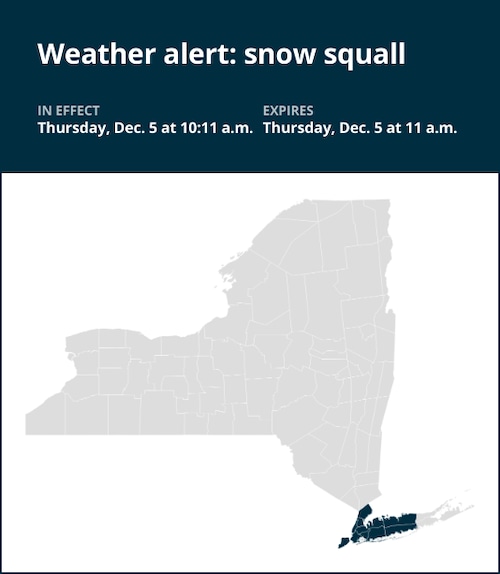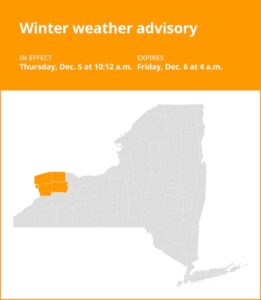The National Weather Service issued a weather alert at 10:11 a.m. Thursday for a snow squall through 11 a.m. in the counties of Manhattan, the Bronx, Staten Island, Brooklyn, and Queens, as well as Westchester, Suffolk, and Nassau.
“At 10:11 a.m., a snow squall was along a line extending from Paterson to Park Slope to Oakwood to Edison and moving east at 45 MPH,” according to the weather service.
Newark, Jersey City, Jamaica, Paterson, Elizabeth, Flatbush, New Rochelle, Flushing, Passaic, Bayonne, Mott Haven, Levittown, Hoboken, Bloomfield, and East Tremont are among the places affected by the alert.
“In winter weather conditions, conditions can rapidly deteriorate,” the weather service says. Be ready for roads covered with ice or snow. To get to your destination, slow down and give yourself more time.
Navigating snow squalls: Understanding, preparing, and staying safe
What are snow squalls?
Strong cold fronts are frequently linked to snow squalls, which are severe winter weather conditions. Even in the absence of a significant winter storm, they can swiftly cover roads with snow and ice. Even while these squalls usually last less than an hour and only produce light snow accumulation, their restricted visibility, strong winds, and quickly falling temperatures can make them dangerous. Unfortunately, in the past, these circumstances have played a role in catastrophic and occasionally fatal road accidents.
Understanding snow squalls vs. Snowstorms
The length of the event distinguishes a snowstorm from a snow squall. Typically lasting between 30 and 60 minutes, snow squalls are incredibly powerful. Days or even hours may pass during a snowfall.
Snow squall warnings
Like warnings for tornadoes or severe thunderstorms, snow squalls are quickly issued for specific locations. They provide vital, locally relevant information that can save lives. If there is a snow squall warning in your location, it is recommended to wait until the squall passes before driving.
Actions to take
When a snow squall warning is issued, people should heed the weather service’s instructions, which include the following crucial steps:
Avoid or postpone travel: It is best to wait until the snow squall has gone through your area before driving if a snow squall warning has been issued for your area. During snow squalls, roadways and highways are especially dangerous.
Decrease speed and improve visibility: If you are already traveling and won’t be able to get off the road in time, slow down and activate your headlights and hazard lights.
Keep a safe distance by giving the automobile in front of you plenty of space.
Steer clear of sudden braking: It’s also best to avoid applying the brakes too hard. This could lead to a loss of vehicle control and raise the possibility of a chain reaction collision on slick or icy roads.
Winter weather safety advice: Go to the weather service’s Winter Weather Safety page for detailed instructions on how to keep safe before, during, and after experiencing winter weather. This website provides helpful advice and safety measures to assist you successfully deal with the difficulties presented by winter weather.
Prepare your car: Take proactive steps to get your car ready for winter driving conditions before you leave. This entails making sure your car’s fluids are topped off and inspecting your tires, brakes, and lights. The difficulties of winter driving are better handled by a well-maintained car.
Important supplies for your car’s emergency kit: Make sure your car has a complete emergency kit that includes necessities like blankets, water, non-perishable food, a flashlight, and a first aid kit. To improve tire traction, don’t forget to have jumper cables, flares or a reflective triangle, ice scraper, a map, a car cell phone charger, and cat litter or sand. In the event of an emergency or unplanned breakdown while traveling, these provisions may prove to be quite beneficial.
In conclusion, putting one’s own safety first and following the weather service’s advice can greatly reduce dangers when a snow squall warning is in effect. People can travel through these winter dangers with more assurance and security if they are aware of them, plan beforehand, and remain alert.
United Robots offers a service called Advance Local Weather Alerts that gathers the most recent information from the National Weather Service using machine learning.
Note: Every piece of content is rigorously reviewed by our team of experienced writers and editors to ensure its accuracy. Our writers use credible sources and adhere to strict fact-checking protocols to verify all claims and data before publication. If an error is identified, we promptly correct it and strive for transparency in all updates, feel free to reach out to us via email. We appreciate your trust and support!







+ There are no comments
Add yours